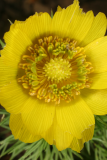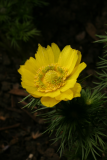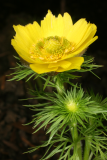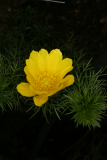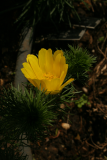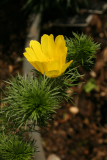Additional notes (click to expand)
Commemorative
We grow this the golden-flowered Adonis vernalis, the spring Adonis, in memory of Adonis, the Greek god of plants, who disappeared into the earth in the winter and reappeared in the spring. The flowers were said to have sprung from his blood when he was gored to death by a wild boar, but this plant must have been the blood-red Adonis aestivalis, the summer Adonis.
The god’s charges included medicinal plants, we feel he is somewhat of an apothecary.
Oakeley, Dr. Henry. (2012). Doctors in the Medicinal Garden. Plants named after physicians. Royal College of Physicians.
link
Horticulture
Adonis vernalis is a hardy perennial in the Ranunculaceae family, found on sandy soils in heath, grassland and pine woodlands across Europe. It forms mounds of feathery leaves and striking buttercup-like flowers in spring. It grows happily in the Medicinal Garden at the front of a raised, well-drained border in full sun, with an annual mulch of leaf mould. On planting, the crowns should be a couple of centimetres below the soil surface. Adonis aestivalis is an inhabitant of farmland in southern Europe, North Africa and Asia. It is a pretty, hardy annual with feathery foliage and small, black-centred, red fl owers in early summer. Seed can be sown in shallow drills, in a well-drained sunny border, then thinned out as necessary. Ripe seed can be collected and saved for sowing the following year. [Clare Beacham]
Oakeley, Dr. Henry. (2012). Doctors in the Medicinal Garden. Plants named after physicians. Royal College of Physicians.
link
Medicinal
Not used as toxic.
Nomenclature
Flos Adonis or Adonides. The red Adonis aestivalis was known as Red Maythes and Red Camomil. (p.386)
Gerard, John. (1975). The Herball or General History of Plants, Dover Publications Inc.. Johnson, Thomas. Facsimile 1633 ed Gardeners' Office library
Other use
Gerard (1633) recommends it for renal stone and intestinal colic, but it is toxic and poisons horses so best avoided.
Oakeley, Dr. Henry F. (2013). Wellcome Library notes.
link
Phytochemistry
Active principle: all parts: adonitoxin and other cardiac glycosides (cardenolides).
Wink, M. (2009). Mode of Action and toxicology of plant toxins and poisonous plants. Mitt. Julius Kuhn-Inst. 421:93-111. p.98
Toxicity
Class 1b: Highly hazardous: cardiac glycosides inhibit Na+,K+-ATPase, symptoms of cardiac glycoside poisoning, diuresis, irritation of GI tract with strong diarrhoea, cardiac arrest.
Wink, M. (2009). Mode of Action and toxicology of plant toxins and poisonous plants. Mitt. Julius Kuhn-Inst. 421:93-111. p.98
Geographical distribution
- Asia-Temperate, Caucasus
- Asia-Temperate, Siberia
- Europe, Eastern Europe, Northwest European Russia
- Europe, Eastern Europe, Ukraine
- Europe, Middle Europe, Austria
- Europe, Middle Europe, Germany
- Europe, Middle Europe, Hungary
- Europe, Middle Europe, Poland
- Europe, Middle Europe, Slovakia
- Europe, Middle Europe, Switzerland
- Europe, Northern Europe, Sweden
- Europe, Southeastern Europe, Bulgaria
- Europe, Southeastern Europe, Italy
- Europe, Southeastern Europe, Romania
- Europe, Southwestern Europe, France
- Europe, Southwestern Europe, Spain
Adonis vernalis L.
Family: RANUNCULACEAEGenus: Adonis
Species: vernalis L.
Common names: Bird's Eye; False Hellebore; Great Ox Eye
Distribution summary: Europe
Habit: Perennial
Hardiness: H5 - Hardy; cold winter
Habitat: Heath, grassland, open pine woodland, on calcareous or sandy soils.
Garden status: Currently grown
Garden location: Europe & Mediterranean (E)
Flowering months: April, May
Reason for growing: Medicinal, toxic
